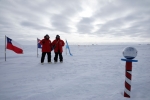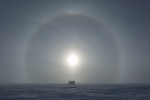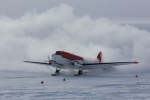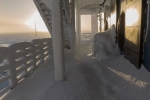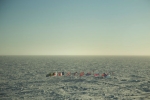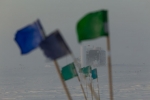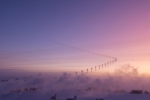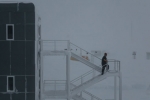Last week at the Pole was a week of no airplanes. Not only did that postpone the departure of current IceCube winterovers Mack and Christian (who was captured in this image expressing his feelings about the delay), but it prevented US Secretary of State John Kerry from making a scheduled visit to the South Pole.
Last week brought two new IceCube winterovers (James Casey and Martin Wolf) to the South Pole, fresh and ready for action. Outgoing winterovers (Christian Krueger and Mack van Rossem) were still at the Pole, available to provide some welcome training before they leave the ice (which can feel as though it may never happen, with only 3 of 12 planned flights making it last week due to one issue or another—such is life at the South Pole).
Come summer, station personnel eagerly await the first provisions of “freshies,” as they’re called at the Pole. Despite continuing delays last week, a couple more planes have come and gone, leaving a few new faces along with the fresh fruit and bringing the station population to over 50.
This nice sun halo (properly called a 22º halo) that appeared directly above the IceCube Lab meant that there were ice crystals in the atmosphere, one of the reasons that the skiway wasn’t seeing enough action last week. Some folks were all packed up and ready to leave, but no plane was there to take them away as the flight schedule kept being pushed back due to weather. Such is life at the South Pole.
Last week at the Pole, the first two planes of the season arrived (and then departed again—both had short stays). They were small planes, but still, any plane landing at the Pole these days is an exciting event after the long, dark, quiet winter.
Although the South Pole is essentially a desert, a hefty accumulation of snow occurs on and around the buildings there each winter. How is that? Well, it’s the wind. Antarctica is a windy place—even with so little precipitation, it features some extraordinary blizzards thanks to strong winds.
With the sun out, you can see again—and here we see all the flags surrounding the marker at the ceremonial pole. They didn’t just appear out of the darkness, though. They were recently replaced for the summer season after being taken down for the winter.
Flags serve an important purpose at the Pole, marking out routes between places for when visibility is poor. Here you can see the IceCube Lab (ICL) in focus behind a flag line in the foreground.
Up, up, and away. That’s a NOAA balloon launch shown in a time-lapse photo—pretty nice! Last week at the Pole was all about the camera.
A new temperature record for 2016 was set at the Pole last week—a low of –107.9 °F. The extremely cold temperatures didn’t stop one station inhabitant from climbing the outdoor staircase is short sleeves.


